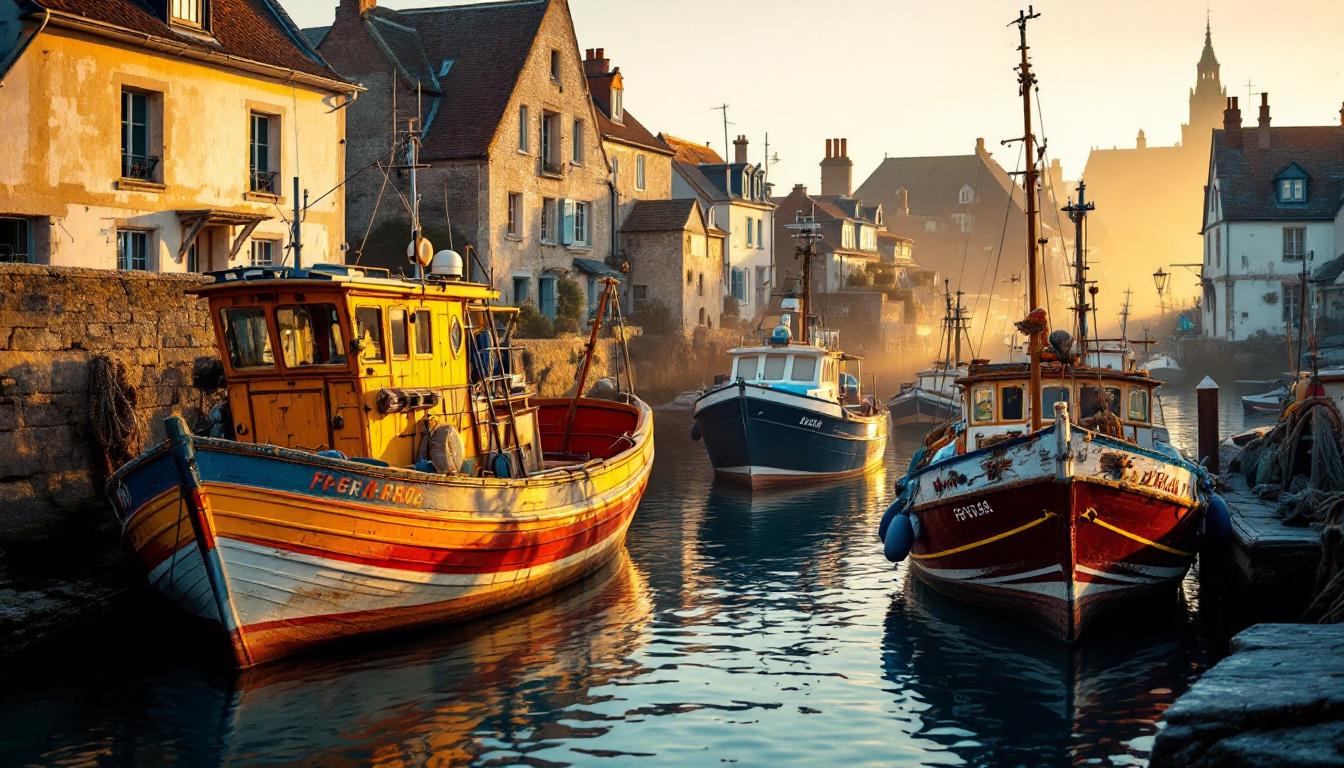The fishing boats bob gently in Fécamp’s harbor at dawn, their weathered hulls bearing witness to centuries of maritime tradition. While tour buses thunder past toward crowded Honfleur and overpriced Deauville, this authentic Norman port remains exactly as local fishermen want it: theirs to protect.
Jean-Claude Dubois, third-generation harbormaster, watches nervously as cruise ship passengers occasionally wander into his village. “We don’t want to become another Honfleur,” he confides, referring to the picturesque port now suffocated by €15 crêpes and souvenir shops. His concern reflects a growing sentiment among Fécamp’s 18,000 residents.
This isn’t resistance born from rudeness—it’s cultural preservation in action. Local fishing families have witnessed neighboring towns transform from working ports into tourist playgrounds, losing their souls in the process.
Why locals guard their fishing heritage fiercely
The morning ritual tourists would destroy
At 5 AM, Fécamp’s harbor comes alive with authentic maritime choreography. Fishermen mend nets, load ice, and prepare for Channel crossings that have sustained families for generations. This sacred rhythm, locals fear, would vanish under the weight of Instagram crowds seeking the perfect sunrise shot.
Economic independence they refuse to surrender
Unlike Deauville’s €200-per-night hotels or Honfleur’s tourist-trap restaurants, Fécamp maintains working-class affordability with authentic bistros serving €12 fish stews. Residents earn livelihoods from fishing, not serving overpriced coffee to day-trippers, creating genuine economic resilience that mass tourism would threaten.
The authentic experiences locals reluctantly share
Secret access to Benedictine palace mysteries
While cruise passengers rush through Normandy highlights, patient visitors discover the Palais Bénédictine’s hidden chambers and secret recipe vault. Local guide Marie Leclerc leads intimate tours, sharing stories her grandfather told about monks creating this mysterious liqueur in 1510—knowledge she’d rather not broadcast widely.
Alabaster coast viewpoints only residents know
Beyond the famous Étretat cliffs crawling with selfie-stick wielding tourists, Fécamp’s locals guard unmarked paths leading to pristine chalk cliff panoramas. These secret viewpoints offer Channel vistas without crowds, accessible only through relationships with protective residents who share reluctantly with respectful visitors.
Traditional culture under tourism pressure
Fishing festivals locals want to keep intimate
Each September, Fécamp celebrates its maritime heritage with the Fête de la Mer, featuring blessing of the fleet ceremonies dating to medieval times. Residents dread the day tour operators discover this authentic celebration, potentially transforming their spiritual tradition into commercialized spectacle for Instagram content.
Family recipes served in protective secrecy
At Restaurant du Port, owner Claude Moreau serves traditional matelote normande using his grandmother’s 1890s recipe, available only to locals and visitors who arrive through word-of-mouth recommendations. He refuses guidebook publicity, protecting both recipe authenticity and intimate dining atmosphere from tourist invasion.
The delicate balance residents desperately maintain
Sustainable tourism they cautiously embrace
Local authorities promote “slow tourism” initiatives limiting large group visits and encouraging individual exploration of maritime museums and cliff walks. This careful approach protects community character while allowing respectful cultural exchange with visitors who understand Fécamp’s protective stance.
Future generations they’re determined to protect
Teenage apprentice fisherman Thomas Leroy represents what locals fight to preserve: young people choosing traditional maritime careers over tourism service jobs. His choice to continue family fishing traditions, rather than serve tourists, embodies the authentic cultural continuity residents desperately want to maintain.
Fécamp remains a living fishing village precisely because locals actively resist becoming another tourist destination. Their protective stance isn’t unfriendliness—it’s cultural survival instinct honed by watching neighboring ports lose their authentic character.
If you’re drawn to this remarkable Norman harbor, approach with respect for the community that created its authentic charm. Visit the medieval French village locals don’t want on Instagram, explore a hidden French spa town, or discover a Breton island car-free paradise where similar protective communities maintain their cultural treasures against tourism pressures.
Essential questions about visiting Fécamp respectfully
How can visitors support local fishing families?
Shop at the morning fish market, dine at family-run restaurants serving traditional recipes, and respect fishing schedules by avoiding harbor areas during active operations.
What time should tourists avoid the harbor?
Early morning hours (4-7 AM) are reserved for fishing operations. Respectful visitors explore the harbor after 9 AM when boats have departed.
Are there accommodation options locals prefer?
Small family-run hotels and chambres d’hôtes rather than large chains help maintain community character and direct tourism revenue to local families.
How do locals feel about photography in fishing areas?
Ask permission before photographing working fishermen or their equipment. Many appreciate interest but want respect for their professional workspace.
What authentic experiences do locals recommend?
Benedictine palace tours, Les Pêcheries maritime museum, cliff walks on marked paths, and traditional restaurants serving local catch with Norman cider.
